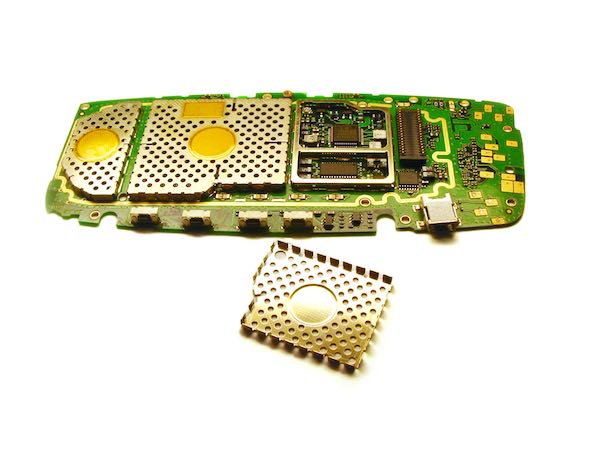
[Image above] MXene is a nanomaterial that is both thin and light, but also has the unique ability to block and absorb electromagnetic radiation, which makes it the perfect for use as shielding in electronic devices. Credit: Drexel University
We are awash in electromagnetic radiation.
Emanating from everything from your microwave to your radio to the sun to the universe, the stuff is everywhere.
While there are widely dissenting opinions regarding the health impact of pervasive electromagnetic radiation, it’s well-known that electromagnetic radiation can negatively impact the performance of electronic devices such as your smartphone.
And the next generation of electronic devices, including integrated wearables and thinner-than-ever smartphones, are increasingly subject to interference from that electromagnetic radiation.
“As technology evolves and electronics become lighter, faster, and smaller, their electromagnetic interference increases dramatically,” says Babak Anasori, research assistant professor at Drexel University, in a recent Drexel news release. “Internal electromagnetic noise coming from different electronic parts can have a serious effect on everyday devices, such as cell phones, tablets, and laptops, leading to malfunctions and overall degradation of the device.”
So researchers at Drexel University (Philadelphia, Pa.) and Korea Institute of Science & Technology (Seoul, South Korea) are working together to develop new materials into incredibly thin and lightweight films than can more effectively block electromagnetic radiation.
Smartphones and other electronics already incorporate electromagnetic shielding. But although current shields are effective, they rely on a layer of metal foam or ink—usually copper or nickel—on the inside of devices to block radiation.

Metal shielding inside an electronic device. Credit: Petteri Aimonen; Wikimedia Commons
“In general, adequate shielding can be achieved by using thick metals, however, material consumption and weight leave them at a disadvantage for use in aerospace and telecommunication applications,” Anasori says in the release. “Therefore, it is of great importance to achieve better protection with thinner films.”
To replace traditional metal shields, the research team turned to a new class of materials to develop atomically thin films that, despite their thinness, can better block electromagnetic radiation than existing shields.
The new thin films are made of MXene materials, a family of 2-D materials composed of transition metal carbides and nitrides. MXenes, discovered at Drexel in 2011, are thin layers etched from MAX phases, a family of hexagonal layered ternary transition metal carbides and nitrides.
But what makes MXenes superior shields even in thinner films?
MXene materials’ structure is key—it blocks electromagnetic radiation two ways. The films first reflect most electromagnetic waves off their surface. But they also secondly block waves that do pass through the surface by internally reflecting the waves, causing the waves to bounce around within the film until they dissipate their energy.

Diagram of how MXene materials block electromagnetic radiation. Credit: Drexel University
The Drexel researchers tested films of varying thicknesses, from a couple of micrometers up to 45 micrometers, to determine just how thin they could go while still effectively blocking electromagnetic radiation.
Even the thinnest films of MXene materials shielded as effectively as copper and aluminum foils, demonstrating the potential of this material to reduce bulk and weight in future electronics.
And increasing the thickness to just 8 micrometers allowed MXene films to perform even better than existing metal foils, blocking 99.9999% of radiation in the range that is emitted from cell phones to radar, the scientists report.
Hear more about the research in this short video from Drexel.

Credit: Drexel University; YouTube
While the materials aren’t yet ready for commercial scale-up, they have the potential, according to lead researcher and ACerS Fellow Yury Gogotsi, Distinguished University and Trustee Chair professor in the College of Engineering and director of the A.J. Nanomaterials Institute at Drexel.
MXene films don’t contain rare-earth elements, can easily be manufactured in a standard chemistry lab, and can be combined with polymer films to form composites—all pluses when it comes to scale-up potential. Plus, MXenes can be combined with a polymer solution so that they can be sprayed-on, making integration a cinch.

A Drexel University researcher sprays on a MXene–polymer coating. Credit: Drexel University
But before the films find their way into next-gen electronics, the team wants to better understand the materials it’s working with. “We need to achieve higher mechanical properties, better understand the effect of the kind of polymer added, and investigate effects of many other factors on the film properties,” Gogotsi says in an email. “This is just the beginning of research on interactions of this new family of 2-D materials with electromagnetic radiation.”
While the team tested titanium carbide MXene films, there are many more options, Gogotsi adds—20 MXene materials have been produced so far, and dozens more can be synthesized. So the team will continue to investigate the fundamental properties of this class of materials and model their interactions with electromagnetic waves to determine which MXene materials might provide the best shields.
“With technology advancing so fast, we expect smart devices to have more capabilities and become smaller every day. This means packing more electronic parts in one device and more devices surrounding us,” Gogotsi says in the Drexel news release. “To have all these electronic components working without interfering with each other, we need shields that are thin, light and easy to apply to devices of different shapes and sizes. We believe MXenes are going to be the next generation of shielding materials for portable, flexible, and wearable electronics.”
The paper, published in Science, is “Electromagnetic interference shielding with 2D transition metal carbides (MXenes)” (DOI: 10.1126/science.aag2421).
Author
April Gocha
CTT Categories
- Electronics
- Material Innovations
- Nanomaterials


